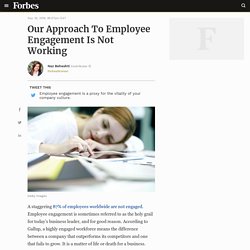

Our Approach To Employee Engagement Is Not Working. A staggering 87% of employees worldwide are not engaged.

Employee engagement is sometimes referred to as the holy grail for today’s business leader, and for good reason. According to Gallup, a highly engaged workforce means the difference between a company that outperforms its competitors and one that fails to grow. It is a matter of life or death for a business. In the United States alone, businesses spend hundreds of millions of dollars to improve employee engagement.
Yet progress toward a more fully engaged workforce has been minimal. Although many give lip service to a holistic philosophy, most approach the issue in a piecemeal, fragmented way. Buckets are small, and so is our thinking about employee engagement. We need to think bigger and in terms that embrace the whole of our employees. Employee engagement and the bottom line The stakes are high. 41% less absenteeism 24% less turnover 21% greater profitability 17% greater productivity. A former Google and Apple exec says there are 4 ways to lead a team — and 3 are ineffective, Business Insider - Business Insider Singapore.
Holacracy: A Radical New Approach to Management. This Email From Elon Musk to Tesla Employees Describes What Great Communication Looks Like. Subject: Communication Within TeslaThere are two schools of thought about how information should flow within companies.

By far the most common way is chain of command, which means that you always flow communication through your manager. The problem with this approach is that, while it serves to enhance the power of the manager, it fails to serve the company.Instead of a problem getting solved quickly, where a person in one dept talks to a person in another dept and makes the right thing happen, people are forced to talk to their manager who talks to their manager who talks to the manager in the other dept who talks to someone on his team.
Then the info has to flow back the other way again. This is incredibly dumb. Any manager who allows this to happen, let alone encourages it, will soon find themselves working at another company. 11 Impact You accomplish amazing. How Much Do Our Employees REALLY Love Their Job? Helen Fisher, Ph.D is a biological anthropologist and chief scientific advisor to the Internet dating site Match.com.

Helen’s life work is centered around the Three Loves Theory, which helps us better understand our relationships. The Three Loves Theory basically says not all love we feel is experienced equally. Fisher has studied the cognitive and neurobiological processes underlying attraction and love, and has begun to pinpoint different emotions that occur at different stages of romantic relationships. She believes we have three kinds of love: Lust, Passion and Commitment. So, what does this have to do with Human Resources? Is this how people “love” their job? Think about it for a second and chart your employees, who “love” their job, in the following categories: Lust – It’s that new love of the job and organization.
Culture. Adapt to individuals. Employees first. Case Studies. Michael Saladino Presentation: "Why Red Lining Your Team Leads To Ineffectiveness" How to grow confidence, a true story in three stages. How Do You Turn a Vicious Cycle of Distrust Into a Virtuous Cycle of Trust? Very often, I see this cycle occurring in studios: I call this the "Vicious Cycle of Distrust".

Having been on both sides of this cycle, I'm quite familiar with the damage it does to a culture. I've also seen the reverse of this cycle, I call a "Virtuous Cycle of Trust": I've changed the term "management" to "leadership" because a significant purpose of leadership is to drive this cycle, to create safety and purpose. I've also called out "teams and individuals" rather than "developers" because the two act differently and teams are ideally more capable than just the sum of individuals.
I've also left some question marks at the interfaces as a question to you. Be More Productive. Shorten the Workweek. Finger on nose: how to make fast decisions? Management Secrets: Core Beliefs of Great Bosses. A few years back, I interviewed some of the most successful CEOs in the world in order to discover their management secrets.

I learned that the "best of the best" tend to share the following eight core beliefs. 1. Business is an ecosystem, not a battlefield. Average bosses see business as a conflict between companies, departments and groups. They build huge armies of "troops" to order about, demonize competitors as "enemies," and treat customers as "territory" to be conquered. Extraordinary bosses see business as a symbiosis where the most diverse firm is most likely to survive and thrive.
Weekend Reading: Becoming the Leader You Aspire To Be. Some of the world’s most renowned business executives and political leaders — including IMF Managing Director Christine Lagarde and former Florida Governor Jeb Bush — came together at The Wall Street Journal’s CEO Council this week to discuss their priorities that will shape 2015.

Talk about a room full of power! How did they all rise to the top? What embodies a great leader and how can you be one, too? There’s lots of leadership advice out there. Here are three great decks that caught our attention.